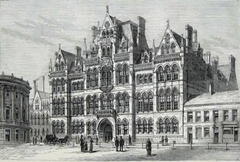Swale Vincent
| Thomas Swale Vincent | |
|---|---|
| Born | 24 May 1868 |
| Died | 31 December 1933 (aged 65) |
| Residence | England |
| Nationality | British |
| Alma mater | Mason Science College (later the University of Birmingham) |
| Known for | Early research on ductless glands |
| Scientific career | |
| Fields | Physiologist; endocrinologist |
| Institutions |
Mason Science College later the University of Birmingham) University of Manitoba University of London |
Thomas Swale Vincent (24 May 1868 – 31 December 1933) was a British physiologist.
Early years
Thomas Swale Vincent was the son of J. Vincent and Margaret Swale.[1][2] He was educated at King Edward VI Grammar School in Birmingham,[1][2] and subsequently studied at Mason Science College (which later became the University of Birmingham), graduating MB in 1894.[3][1][2] At age 24, Swale qualified in medicine, and travelled to the University of Heidelberg to study under Albrecht Kossel.[1] He then returned to Mason Science College as a demonstrator of physiology.[1]
Career
In 1896, Vincent's first paper, entitled "The Suprarenal Capsules in the Lower Vertebrates," was published in The Proceedings of the Birmingham Natural History and Philosophical Society.[1] This research earned him a BMA Research Scholarship,[1] presenting the opportunity to work with E.A. Schäfer, the original discoverer of the suprarenal capsules, at University College in London.[1] In 1897, Vincent succeeded Benjamin Moore as Sharpey Scholar,[1] becoming assistant professor to Schäfer, and, in 1899, to Ernest Starling.[1]
In 1900, Vincent was appointed a lecturer at Cardiff, where his students included future cardiologist Thomas Lewis, with whom he published two papers on the biochemistry of muscle.[1] Lewis later wrote, "I have always been grateful to Vincent for giving me my first introduction to scientific work."[1] Two years later, he was awarded the Francis Mason Research Scholarship,[1] and rejoined Schäfer, now at the University of Edinburgh, to study the physiology of the thymus and other ductless glands.[1] In 1904 he was awarded a Doctor of Science from the University of Edinburgh for his thesis on Addison's disease and the functions of the suparenal capsules.[4]
In 1904, Vincent was appointed the first Professor of Physiology at the University of Manitoba in Winnipeg, Manitoba, Canada.[1][5] Here, he oversaw the research of biochemist Alexander Thomas Cameron, and was influential in fostering Cameron's interest in endocrinology.[6] Vincent remained at Manitoba until 1920, when he returned to London to become Professor of Physiology at Middlesex Hospital.[1] He retired from this post in 1930.[1]
Personal life
In 1914, Vincent married Beatrice, daughter of Mr. W. Overton, and had two daughters; all three survived him.[1] Vincent's shyness sometimes gave an impression of brusqueness, but friends knew him as a "staunch friend and a charming companion."[1] Vincent, who practised as a pianist, also had a deep love of music.[1]
Attitudes
Vincent's research on endocrinology earned him a strong international reputation in his field.[1] He was known for his "highly critical and sceptical mind,"[1] and was described by colleague William Cramer as "a man of firm principles and high ideals on which he would not compromise." [1]
References
- 1 2 3 4 5 6 7 8 9 10 11 12 13 14 15 16 17 18 19 20 21 22 23 C. Lovatt Evans (1934) "T. Swale Vincent, M.D., D.Sc., Ll.D. Formerly Professor Of Physiology, University Of London," The British Medical Journal, Vol. 1, No. 3810 (Jan. 13, 1934), pp. 83-84
- 1 2 3 British physiologists 1885-1914: a biographical dictionary, Manchester University Press ND, 1991, p513-5
- ↑ http://www.ulrls.lon.ac.uk/resources/general_register_part_3.pdf
- ↑ Vincent, Thomas Swale, (1904). "Addison's disease and the functions of the suparenal capsules".
- ↑ Ian Carr & Robert E. Beamish (1999) Manitoba medicine: a brief history, Univ. of Manitoba Press, p55
- ↑ White, F.D. & Collip J.B. (1948) "Obituary Notice: Alexander Thomas Cameron, 1882-1947," Biochemical Journal, 43(1): 1–2
